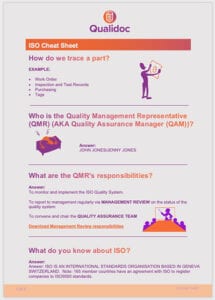Given the never-ending discussions on measurement my readers might find the following expansion of Management Review responsibilities and authorities helpful in deciding what should be measured for customer satisfaction and customer improvement. The standard only requires that measurement and analysis should take place within these contexts; it does not prescribe methods or identify what should be measured.
I am increasingly concerned about the emphasis on assigning numbers to conditions. Too much time is being wasted on identifying what is measurable without considering which measurements are beneficial to the company and the customer, which should be the only criteria for measurement.
MANAGEMENT REVIEW AGENDA for I.M. Happy Company (IMH)
REPORTS
QUALITY MANAGEMENT REPRESENTATIVE (QMR)
- Status of Actions from last Management Review
- Report on quality system development
- Work in hand on the quality system
- Risk assessment and risk management for unresolved nonconformities (e.g., supplier, effect on delivery of services to customers)
- Changes which could affect the quality system (regulatory, industrial codes, international standards)
CEO
- Status of Actions from last Management Review
- Resources needed for quality system tasks
- Identify position of quality system development in the IMH business development plan
- Risk assessment and risk management
- Performance of services, operational processes, associated practices
- External changes which could affect the quality system (legislation, industry standards)
- Quality planning and objectives (needs and expectations of customers and other interested parties)
- Business decisions as assessed for their impact on the quality system
- The impact of the quality system on business decisions
OTHER ATTENDEES
- Preventive action strategies (risk assessment and risk management)
- Quality objectives (strategies for continuous improvement)
- Cost of quality system
- Benefits of quality system
- Training
- Customer satisfaction levels (implied needs, measurement and analysis techniques)
- Customer complaints
- Changes which could affect the quality system
Preventive Action strategies
- identify items and conditions for improvement in IMH processes
- identify what has been done to date (e.g., improvement in processes, equipment, staff training)
- Refer to QMR reports for possible improvements
Quality Objectives
Identify all components of IMH services which are affected by quality system development, e.g.;
- Customer requirements
- What is happening to our customer (changes that would affect IMH services)
- Resources required (e.g., equipment, skills, labour, time)
- Training
- Processes (administration, production)
Cost of quality system
- Cost of quality system; e.g., staff time, consulting fees, equipment, staff training
- Projected costs for quality system development during, and until, assessment and certification stage
Benefits of quality system
- Identify benefits to date; e.g., production time saved, processes clearly understood and verified by users, authority and responsibility identified
Customer Satisfaction levels and customer complaints
- Identify method(s) for measuring customer satisfaction. What constitutes customer satisfaction for IMH customers? Where is this not happening? How can we improve our service to customers? (anticipating customer needs at quotation and contract stages). These might not be contained in the Request for Proposal or Quotation from the customer.
Measurement and Analysis techniques
- Identify trends which can be measured; e.g., nonconformity, market trends (measurements must be beneficial to the organisation and improve organisation’s performance)
